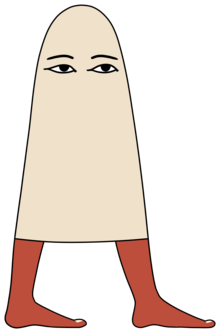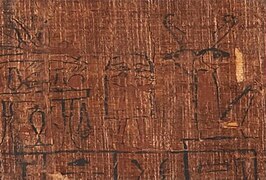Medjed
| Medjed | |
|---|---|
 A depiction of Medjed based on theGreenfield papyrus.The original papyrus illustrations are colourless outlines. |
InAncient Egyptian religion,Medjed(Egyptological:mḏd) is a minordeity[a]mentioned in certain copies of theBook of the Dead.While not much is known about the deity, his ghost-like depiction in theGreenfield papyrushas earned him popularity in modern Japanese culture, and he has appeared as a character in video games andanime.
In theBook of the Dead
[edit]TheBook of the Deadis made up of a number of individualAncient Egyptian funerary textswith accompanying illustrations. They are in general written on papyrus and were used from the earliest period of theNew Kingdom(c. 1550 BCE) until around 50 BCE. These texts consist of magic spells, some of which are to grant the dead person mystical knowledge in the afterlife, or to give them control over the world around them through their journey in theDuat,or underworld.[4]
Of theBook of the Deadcopies that have been found, a limited number reference an obscure entity in spell 17b named "Medjed" (also spelled "Metchet" ),[5]which means "The Smiter".[1][6]In an English translation of thePapyrus of Ani,Raymond O. Faulknerrenders the portion of the spell referring to Medjed as follows:
I know the name of that smiter [i.e.,Medjed] among them who belongs to the House of Osiris, who shoots with his eyes, yet is unseen. The sky is encircled with the fiery blast of his mouth andHāpimakes report, yet he is unseen.[7]
Apart from this short passage, nothing is known about Medjed.[8]Hermann Grapowproposed that Medjed could refer to a star (given that Medjed is said to radiate light and to have a connection with the cyclicalflooding of the Nile), but as Ilaria Cariddi notes, the name is never written with a stardeterminative.[9]
Visual depictions
[edit]According to Ilaria Cariddi, visual representations of Medjed can be found on only nine papyrus scrolls, all of which date to around the time of Egypt'sTwenty-first Dynasty(1077–943 BCE).[10]These scrolls (of which theGreenfield papyrusis arguably the most well-known)[8][11][12]are as follows:
| Papyrus | Date | Location | Citation |
|---|---|---|---|
| Papyrus Bodmer 101 | Twenty-first Dynasty | Bodmer Foundation | [13][14] |
| Papyrus Bodmer 102 | Twenty-first Dynasty | Bodmer Foundation | [13][14] |
| Papyrus Turin 1818 | Twenty-first Dynasty | Museo Egizio | [13][14] |
| Papyrus Bodmer 100 | Mid-Twenty-first Dynasty | Bodmer Foundation | [13][14] |
| Papyrus London BMEA 9948 | Mid-Twenty-first Dynasty | British Museum | [13][14] |
| Papyrus Cairo S.R. VII 10222 | Mid- or lateTwenty-first Dynasty | Egyptian Museum | [13][14] |
| Papyrus Cairo JE 95658 | LateTwenty-first Dynasty | Egyptian Museum | [13][14] |
| Papyrus Cairo JE 95637 | LateTwenty-first Dynasty | Egyptian Museum | [14][15] |
| Papyrus Greenfield | LateTwenty-first Dynasty/ EarlyTwenty-second Dynasty |
British Museum | [14][16] |
In these scrolls, Medjed is depicted as a dome with eyes, supported by two human-like feet. A few scrolls also portray the deity with a red knotted belt above or below his eyes.[17]The scholarsE. A. Wallis Budge,H. Milde, and Mykola Tarasenko have argued that Medjed's dome-like torso is either a shroud or a "shapeless body" that symbolizes the deity's imperceptible nature,[18][19][20]and Cariddi has proposed that Medjed's prominent eyes and legs could signify that he can "see, move and act even though humans cannot perceive him".[21]In contrast,Bernard Bruyèreand Terence DuQuesne have contended that Medjed is actually a personification of an oil jar, and that his red "belt" is actually a stylized lid fastener.[21][22][23]
In popular culture
[edit]After the Greenfield papyrus illustrations were exhibited in 2012 at theMori Art Museumin Tokyo and theFukuoka Museum of Art,Medjed became aninternet memeon Japanese social media, thanks largely to his "cartoon ghost" -like appearance.[24][25][26][27]He has since entered intoJapanese popular cultureand has appeared in video games (e.g.,Fate/Grand Order)[25][28]and anime (e.g.,Kamigami no KiandOh, Suddenly Egyptian God).[28][29][30]
In the 2016 Japanese video gamePersona 5,his name is used for a fictional antagonistic hacker group that describe themselves as the "true executors of justice".[31]
Gallery
[edit]-
A vignette from the Greenfield papyrus, sheet 12. Medjed is depicted on far-right, with feet facing both directions.
-
A vignette from the Greenfield papyrus, sheet 76. Medjed is depicted on centre-left, with both feet facing right.
-
A vignette from the Papyrus Cairo JE 95658 scroll. Medjed is shown on the far left.
-
A detail taken from the Papyrus Bodmer 100 scroll. Medjed is the figure at centre.
-
A depiction book of the dead depiction of Medjed from Papyrus Bodmer 101. 21st Dynasty. Note the figure in the middle.
See also
[edit] Media related toMedjedat Wikimedia Commons
Media related toMedjedat Wikimedia Commons- Medjed (fish),also worshipped in ancient Egyptian religion
Notes
[edit]- ^Medjed is sometimes referred to as a "demon".[1]However, unlike the contemporary understanding of demons as purely malevolent supernatural entities, the term is often used byEgyptologistsin reference to a variety of supernatural entities, including ghosts, evil or benevolent spirits, minor deities, representations of chaos, and even "personifications of the destructive aspects of the [major] gods".[2][3]
References
[edit]Citations
[edit]- ^abCariddi (2018),p. 197.
- ^te Velde (1975),pp. 980-984.
- ^Lucarelli (2010),pp. 1–7.
- ^Taylor (2010),p. 51–56
- ^Budge (1898),pp. 55–56.
- ^Kytnarová et al. (2018),pp. 15-19.
- ^Andrews & Faulkner (1985),p. 48.
- ^abTaylor, John H. (22 September 2010)."What is a Book of the Dead?".British Museum.Archived fromthe originalon 17 April 2015.Retrieved17 April2015.
- ^Cariddi (2018),p. 203.
- ^Cariddi (2018),pp. 197–200.
- ^Salvador (2017),p. 11.
- ^Cariddi (2018),pp. 201–202.
- ^abcdefgCariddi (2018),p. 197.
- ^abcdefghiBrugière, Sébastien (14 July 2021)."Sur la trace du dieu Medjed"(in French).Bodmer Foundation.Archivedfrom the original on 4 April 2023.Retrieved4 April2023.
- ^Cariddi (2018),pp. 197, 200.
- ^Cariddi (2018),p. 200.
- ^Cariddi (2018),pp. 197, 201.
- ^Budge (1912),p. 13.
- ^Milde (1991),p. 44.
- ^Tarasenko (2012),p. 385.
- ^abCariddi (2018),p. 203.
- ^Bruyère (1939,pp. 182–185, 190, 192.
- ^DuQuesne (2008),p. 19.
- ^Cariddi (2018),p. 204.
- ^ab"Meet Medjed, The Egyptian God Who's Big in Japan!".Tor.com.7 August 2015.Archivedfrom the original on 20 December 2020.Retrieved7 August2015.
- ^Stimson, Eric (31 July 2015)."The Obscure Egyptian God Medjed and His Bizarre Afterlife on the Japanese Internet".Anime News Network.Archivedfrom the original on 8 December 2020.Retrieved7 August2015.
- ^Salvador (2017),p. 11.
- ^abSalvador (2017),pp. 17–18.
- ^"Egyptian God Medjed Stars in New TV Anime Series Starting in November".Anime News Network.25 October 2010.Archivedfrom the original on 13 May 2021.Retrieved13 May2021.
- ^Mateo, Alex (20 November 2020)."Tōtotsu ni Egypt Kami Net Anime Reveals Extended Promo Video, December 7 Premiere".Anime News Network.Archivedfrom the original on 24 November 2022.Retrieved23 January2023.
- ^"August 21 – Persona 5 Guide".IGN.August 16, 2020.RetrievedOctober 28,2023.
Bibliography
[edit]- Andrews, Carol, ed. (1985).The Ancient Egyptian Book of the Dead.Translated by Raymond O. Faulkner (Revised ed.).Austin, TX:University of Texas Press.
- Bruyère, Bernard (1939).Rapport sur les fouilles de Deir el Medineh: 1934–1935(in French).Cairo, Egypt:Institut Français d'Archéologie Orientale.
- Budge, E. A. Wallis (1898).Book of the Dead: the Chapters of Coming Forth by Day.London,England:Kegan Paul, Trench, Trübner & Co., Ltd.– viaThe Internet Archive.
- Budge, E. A. Wallis (1912).The Greenfield Papyrus in the British Museum.London,England:British Museum.RetrievedApril 12,2023– viaGoogle Books.
- Cariddi, Ilaria (2018). "Reinventing the Afterlife: The Curious Figure of Medjed in the Book of the Dead". In Kahlbacher, Andrea; Priglinger, Elisa (eds.).Tradition and Transformation in Ancient Egypt.Vienna,Austria:Austrian Academy of Sciences Press.pp. 197–206.doi:10.2307/j.ctvdf0j5w.15.ISBN9783700180050.S2CID192570521.
- DuQuesne, Terence (2008). "The Great Goddess and her Companions in Middle Egypt". In Rothöhler, Benedikt; Manisali, Alexander (eds.).Mythos und Ritual: Festschrift für Jan Assmann zum 70.Münster,Germany:LIT Verlag.pp. 1–26.ISBN9783825811457.
- Kytnarová, Katarína Arias; Jirásková, Lucie; Odler, Martin (2018). "Old Kingdom Model and Miniature Vessels from Giza". In Kahlbacher, Andrea; Priglinger, Elisa (eds.).Tradition and Transformation in Ancient Egypt.Vienna,Austria:Austrian Academy of Sciences Press.pp. 15–29.doi:10.2307/j.ctvdf0j5w.4.ISBN9783700180050.S2CID134211246.
- Lucarelli, Rita (2010)."Demons (Benevolent and Malevolent)".In Wendrich, Willeke; Dieleman, Jacco; Frood, Elizabeth; Baines, John (eds.).UCLA Encyclopedia of Egyptology.Los Angeles,CA: UCLA Department of Near Eastern Languages and Cultures. pp. 1–10.Retrieved5 April2023.
- Milde, H. (1991).Vignettes of the Book of the Dead of Neferrenpet.Leiden,Netherlands:The Netherlands Institute for the Near East.
- Salvador, Rodrigo (2017)."Medjed: From Ancient Egypt to Japanese Pop Culture"(PDF).Journal of Geek Studies.4(2): 10–20.RetrievedDecember 1,2022.
- Tarasenko, Mykola (2012)."The Vignettes of the Book of the Dead Chapter 17 during the Third Intermediate Period (21st–22nd Dynasties)".Studien zur Altägyptischen Kultur.41:379–394.JSTOR41812234.RetrievedApril 12,2023.
- Taylor, John H., ed. (2010).Ancient Egyptian Book of the Dead: Journey through the Afterlife.London,England:British Museum Press.ISBN9780714119939.
- te Velde, Herman (1975). "Dämonen". In von Wolfgang Helck, Herausgegeben; Otto, Eberhard (eds.).Lexikon der Ägyptologie.Vol. I: A – Ernte.Wiesbaden,Germany:Harrassowitz Verlag.pp. 980–984.






